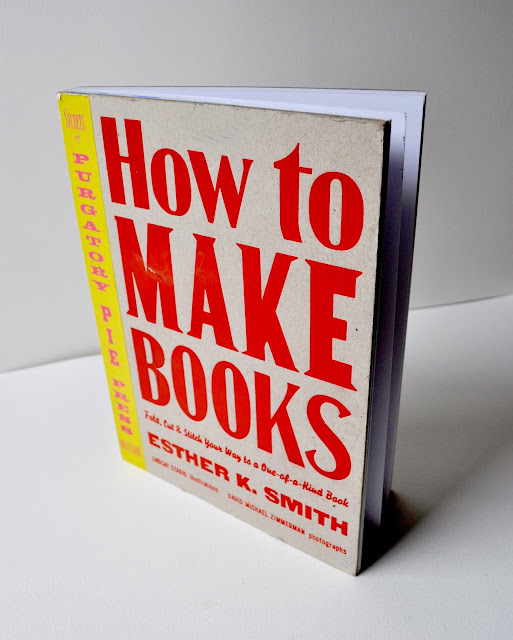I couldn't pick out a favorite among my two dozen or so water tower sketches and thought it would be ideal to collect them all in a miniature book; you don't have to pick a favorite either, collect a dozen in one fell swoop!
2.5" x 3" Handmade paper cover and archival art prints, with leather tie strip
I've made a limited edition of these mini books - 25 in total. Each is signed and numbered inside the front cover.
Here's a quick at-a-glance reference to show you each of the prints that are included in the book:
I'd never made a mini-book before, or any kind of book for that matter. But was inspired after coming across this terrific volume, with a very straightforward title:
The accordion-style book seemed to be the perfect "starter" for a new book maker like me, since there would be no need to actually "bind" the book with a needle and thread. I turned to that section and saw several options and suggestions:
I decided I'd make my first attempt just using inexpensive materials since I was bound to screw it up the first time around. No sense wasting my lovely handmade paper from Thailand and my archival prints on my first effort. Let's just make a down-and-dirty cheapo version first, to make sure I get the process right.
So I decided to follow the plan at the bottom of the page, the H-I-J folds and cuts. I used photoshop to lay out miniatures of some of my pen and ink drawings and just printed them out on regular plain paper with my regular printer. I had the foresight to number the images since I wasn't quite sure where they would appear in the book after the folding, cutting and re-folding took place.
Then I cut according to the instructions in the H-I-J steps:
So far, so good, I'm thinking.......
That is, until I folded it according to the instructions - and some of my lovely ladies were upside down!
See? I knew I would screw something up the first time out of the gate. So I checked which numbered images ended upside down and re-arranged the images in the print file. Seems I had to turn the top row and the third row images upside down so they'd come out properly in the accordion fold. Duly noted!
So let's try this again:
Ok, I didn't take a photo of the next step, the re-folding, but trust me, everybody is now right side up:
Next, cut two pieces of chip board to be used as the "cover." I cut them just slightly larger than the pages:
But before I go to work on those covers, I had to make sure those folds will really hold. I placed the accordion under a very heavy book for several hours:
What better weight than "The History of Art?"
Meanwhile, back to the covers. I knew I wanted to use the lovely handmade paper from Thailand that I had purchased in large sheets. But again, my test book was going to use something more pedestrian, so I could get the process right. My daughters had some decorative papers in their stash:
It was a bit heavier than the papers I planned to use so I affixed it to the chipboard with some rubber cement. A bit messy and probably not the best adhesive for the lighter handmade papers. But for now, it would work.
Cut the paper and trim the corners so they'll fold more easily:
First, I realized that I wanted to make sure the first and last panels on my print page of images were blank; I didn't want an image immediately inside the cover but would leave that space blank for my signature and the edition number.
Second, I decided to use much more lightweight papers and would need to affix the paper with something other than rubber cement.
Third, how would I keep the book closed? I'd seen other books that used a thin leather strap but realized I needed to insert two lengths of the strip in between the cover and the page of the accordion. Doh!
Ok, so now I went ahead with my high-end versions, happy to have made my mistakes on the prototype first.
I pre-cut strips of these beautiful papers -- hand-made in Thailand from mango and/or banana leaves:
But instead of using the rubber cement adhesive, I used this acrylic gel, inside and out. The gel served both to fuse the chipboard to the paper and also to seal the outside and make it more durable:
And this time, I made sure to insert two leather strips just inside the front and back panels, before affixing the accordion to the covers:
And voila!
I deliberated a while about giving it a title -- NYC H20 seemed perfect. I printed the title out on translucent adhesive sheets and finally, I was done!
2.5" x 3" Handmade paper cover and archival art prints, with leather tie strip
I hope you found this tutorial useful -- two more editions of books are in the works, stay tuned!





































3 comments:
greetings vic,
i absolutely love this new addition to your creative ventures!
the mini handmade books are truly little multifaceted gems that sparkle with vhmckenzie style n shine... perfect for displaying series pieces.
as a long time collector of your work, a few of these will have to join the others. no question.
the tutorial and progression posts, as always, are not only enjoyable but inspiring as well... thank you.
not always in view, but always around.
will shoot you an e soon, would love to catch up...
peace.n.love
zan
That is so flippin' cool, Victoria!
DUDE!!!!
Post a Comment